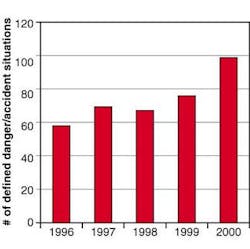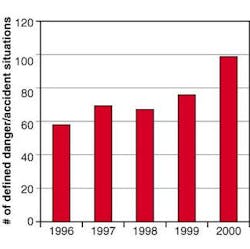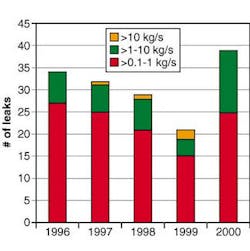NORWAY: Gas leaks, well kicks, other incidents to be probed by NPD safety forum
Concern over deterioration in offshore safety performance has prompted the Norwegian Petroleum Directorate (NPD) to take action to reverse the trend. The directorate has set up a Safety Forum with representatives from all involved parties to discuss new initiatives, and is providing important input for a government white paper that will set guidelines for the future implementation and monitoring of safety measures.
In the spring of this year, NPD published the results of a pilot study undertaken to assess the status of risk trends, with a particular focus on large-scale accidents and personal injury. At first glance, there appeared to be little to worry about - during the 1990s, there were no large-scale accidents, nor, since 1992, any significant fires resulting from hydrocarbon leaks.
However, a closer look at the available evidence identified a number of areas of concern, raising the possibility that the conditions might be emerging for a serious accident in the not-too-distant future. A number of indicators showed a trend towards an increase in risk: a growing number of gas leaks, and a significant increase in the number of well kicks during development drilling.
In the case of mobile units, there has been a heightened risk of collision with other vessels working on the field, and of significant structural damage to installations. In the last two years, the incidence of serious injury to personnel on production installations has been significantly higher than for the past decade as a whole.
A number of other indicators in the NPD pilot study showed a stable level of risk:
- Fires in process facilities not related to hydrocarbon leaks
- Drifting objects on a collision course
- Work accidents involving personal injury on production and mobile installations.
But none of the indicators examined showed a reduction in the level of risk, though for some there was insufficient data to identify a trend. Corroboration for the rise in injuries comes from recently published figures indicating that the state's offshore insurance fund last year made payments for injuries suffered on offshore installations of NKr 653 million ($71 million), about three and a half times higher than just two years before.
"The traditional indicators, such as lost-time injuries, used by the industry and ourselves as regulator are not a good tool for measuring the safety status of activities offshore," says Magne Ognedal, the NPD's supervision director. "We needed new tools, and set up the pilot as a way of looking for them. In the process, we consulted with all the involved parties, including trade unions and academics. We used information that was already available, but in a systematic manner."
In addition to a quantitative appraisal of risk status, the pilot also undertook a qualitative evaluation, talking with the various parties to understand their perception of the trends. Here too there emerged reasons for disquiet - differences in the way operators and employees perceived what was happening, and a low level of trust between them.
"No indicator we studied shows a positive development - they are either flat or going in the wrong direction," says Ognedal. "This underlines the NPD's concern that the positive safety trend flattened out in about the early-1990s, stayed level in the mid-1990s, and started going in the wrong direction in the late-1990s."
It is hard to pin down the exact cause of the deterioration, he says, but it goes back to the late-1980s, when against a background of low oil prices, industry minds were concentrated on initiatives to cut costs and make the Norwegian continental shelf more competitive. Caught up in this tremendous drive, management lost focus on safety in favor of cost-efficiency.
At the same time, the numbers involved in operators' offshore organizations were reduced, with undesirable effects such as increased stress levels and a growing tendency to deviate from laid-down procedures. "Now, the companies need to re-analyze their organization and ensure that they have the necessary capacity and competence," Ognedal says.
Although employee organizations shared the NPD's viewpoint, operators proved resistant to the notions that everything was not going as well as it should, and that new initiatives might be needed. The NPD pointed to the Step Change campaign in the UK sector which had also been prompted by faltering safety performance. In a letter to operators last autumn, it criticized the companies for being too concerned with making savings and not concerned enough with health, safety and environmental matters.
At times, the NPD has had to order a halt to production operations to enable deficient safety arrangements to be tackled. Problems have been identified with some types of barriers - for example, firewater deluge systems, which point to inadequate maintenance procedures. "We've had platforms shut down for a week or two, while they get the fire-water system to work," says Ognedal.
Eventually, however, operators were persuaded of the need to take action. "To reach agreement on how the world looks is a major step," says Ognedal. "Now the focus is on action." Last autumn the NPD set up the Sikkerhetsforum - safety forum - which meets quarterly and in which all interested parties - operators, rig owners, trade unions and authorities - participate.
In addition to discussing new initiatives, it also acts as a hearing forum for submissions to a government white paper on the future course of offshore safety which is to be published in the autumn. The white paper will reflect closely the NPD's preoccupations and initiatives.
The constant effort to improve safety can be seen to have had different foci at different times, Ognedal says: technical issues in the 1970s and into the 1980s, management systems in the 1980s and 1990s, and now safety culture. "If the technical issues and management systems are in place and functioning," Ognedal says. "to improve now, we need to develop the safety culture. This is a difficult issue, to do with the attitude, behavior, and so on, of the management and work force."
Safety culture is also a buzzword for a new committee - Samarbeid for Sikkerhet (Working together for Safety) - which has been set up to provide a meeting place for employers and employees. Committee members include representatives of the Norwegian Oil Industry Association (OLF), Norwegian Shipowners Association and trade unions, while the NPD has observer status.
The directorate will also improve its own reporting to society. Starting next spring it will publish an annual report of the trend measurement of the risk level on the Norwegian shelf.


